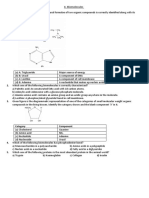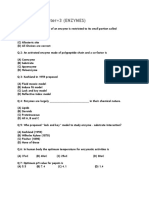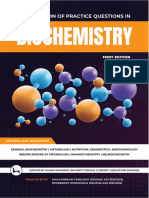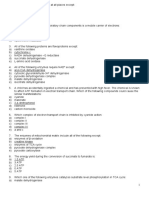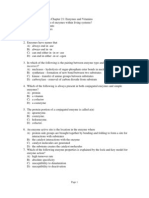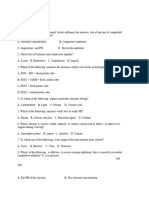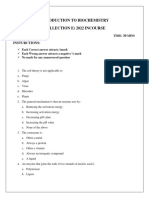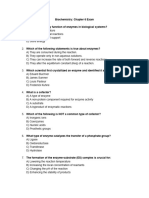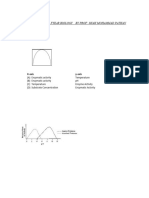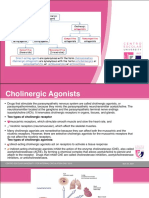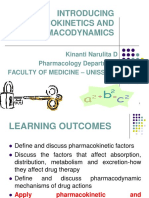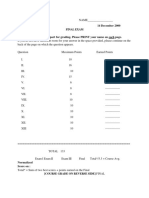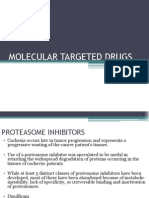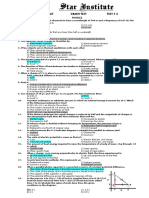Enzymes Work Sheet
Enzymes Work Sheet
Uploaded by
dildil553421Copyright:
Available Formats
Enzymes Work Sheet
Enzymes Work Sheet
Uploaded by
dildil553421Original Title
Copyright
Available Formats
Share this document
Did you find this document useful?
Is this content inappropriate?
Copyright:
Available Formats
Enzymes Work Sheet
Enzymes Work Sheet
Uploaded by
dildil553421Copyright:
Available Formats
ENZYMES
1. The general mechanism is that an enzyme acts by:
A. Reducing the activation energy
B. Increasing activation energy
C. Decreasing pH value
D. Increasing the pH value
2. The coenzyme is:
A. Often a metal
B. always a protein
C. often a vitamin
D. always an inorganic compound
3. Blocking of enzyme action by blocking its active site is called as:
A. Allosteric inhibition
B. Feedback inhibition
C. Competitive inhibition
D. Non-competitive inhibition
4. Enzymes are composed of:
A. Fats
B. Proteins
C. Nucleic acids
D. Vitamins
5. The enzyme which hydrolyses starch to maltose is:
A. Protease
B. Amylase
C. Lactase
D. Maltase
6. This statement about enzymes is true:
A. Enzymes accelerate reactions by lowering the activation energy
B. Enzymes are proteins whose three-dimensional form is key to their function
C. Enzymes do not alter the overall change in free energy for a reaction
D. All of these
7. Koshland proposed which model:
A. Fluid mosaic model
B. Induced fit model
C. Lock and key model
D. Reflective index model
ENZYMES
8. The enzyme minus its coenzyme known as:
A. Apoenzyme
B. Metalloenzyme
C. Isoenzyme
D. All of these
9. Which of the following is the non-protein component of the enzyme?
A. Cofactor
B. Activator
C. Coenzyme
D. All of these
10. An uncatalyzed reaction involved:
A. High activation energy
B. Low activation energy
C. Balanced activation energy
D. All of these
11. Which among them is not attribute of enzymes:
A. Specific in nature
B. Protein in chemistry
C. Consumed in reaction
D. Increased rate of reaction
12. Which among them is a cofactor:
A. Inorganic ion
B. Organic molecule
C. Both A and B
D. None of these
13. Ribozymes were discovered by________ in 1920.
(a) Buuchner (b) Thomas Cech
(c) Sidney Altman (d) Both b & c
14. Enzymes cannot catalyze ______ reaction:
(a) Exergonic (b) Endergonic
(c) Exothermic (d) None of above
15. Which molecules in the body behave as catalyst?
(a) Lipids (b) Proteins
(c) RNA (d) Both b & c
ENZYMES
16. Which of the following is an example of reversible non-competitive inhibition?
(a) E-s complex (b) Un-competitive inhibition
(c) Feed-back inhibition (d) N.O.T
17. Which of the following is non-competitive inhibitor?
(a) Sulfa drugs (b) Cyanides
(c) Pesticides (d) Both b & c
18. Cyanide binds with ______ enzyme complex in ETC.
(a) Peroxidase (b) Cytochrome oxidase
(c) Catalase (d) N.O.T
19. Which of the following enzymes are called as dehydrogenases?
(a) Hydrolases (b) Oxidoreductases
(c) Ligases (d) Nucleases
20. Which enzyme converts Glucose into glucose 6, phosphate?
(a) Transferase (b) Oxidase
(c) Aldolase (d) Polymerase
21. The cofactor which is tightly bound to apoenzyme are:
(a) Coenzyme (b) Activator
(c) Innhibitor (d) Prosthetic group
22. Biotin and ubiquinone are:
(a) Activators (b) Inhibitors
(c) Prosthetic groups (d) A.O.T
23. Which of the following is substrate for Pepsin?
(a) Lipids (b) Carbs
(c) Protiens (d) Carotenoids
24. Substrate when binds with enzyme it alters active site’s shape is feature of:
(a) Lock and key model (b) Furenose model
(c) Induced fit model (d) Fluid mosaic model
25. Enzymes makes maximum products at ______ temperature:
(a) Minimum (b) Optimum
(c) Maximum (d) Enzyme is uneffected
ENZYMES
26. Which of the following is ligase?
(a) DNA-polymarase (b) RNA-Polymerase
(c) Ribozymes (d) All of above
27. Enzyme which is entirely composed of protein is called:
(a) Holoenzyme (b) Simple enzyme
(c) Conjugated enzyme (d) Both a & b
28. Fructose 1-6, biphosphate converted into GAP and DHAP by:
(a) Hydrolase (b) Isomerase
(c) Ligase (d) Lyase
29. Which of the following is specific to substarate?
(a) Allosteric site (b) Actin site
(c) Active site (d) N.O.T
30. Which of the following structure in enzyme is for feed-back inhibition:
(a) Active site (b) Allosteric site
(c) Catalytic site (d) All of above
31. Given below are two statements:
Statement I: Low temperature preserves the enzyme in a temporarily inactive state where as
high temperature destroys enzyme activity because proteins are denatured by heat.
Statement II: When the inhibitor closely resembles the substrate in its molecular structure and
inhibits the activity of enzyme, it is known as competitive inhibitor.
(a) Statement I is true but statement II is false
(b) Statement I is false but statement II is true
(c) Both statements I and II are true
(d) Both statements I and II are false
32. Which of the following statement is true with reference to enzymes?
(a) Coenzyme=Apoenzyme+Holoenzyme
(b) Holoenzyme=Apoenzyme+coenzyme
(c) Holoenzyme=coenzyme+cofactor
(d) Apoenzyme=holoenzyme+coenzyme
33. A non-proteinaceous enzyme is:
(a) Lysosyme (b) Ribozyme
(c) Ligase (d) Deoxyribonuclease
ENZYMES
34. Which of the following statement is incorrect:
(a) Competitive inhibitor does not affect rate of enzyme action
(b) A competitive inhibition can be reversed
(c) Competitive inhibitor is not chemically changed by enzyme
(d) All statements are incorrect
35. Which of the following statement about enzyme is incorrect?
(a) Enzymes are denatured at high temperature
(b) Enzymes are mostly proteins but some are lipids also
(c) Enzymes are highly specific
(d) Enzymes require optimum temperature and optimum pH for maximum activity
36. A competitive inhibitor for succinate dehydrogenase enzyme is:
(a) Malate (b) Ketoglutarate
(c) Oxaloacetic acid (d) Malonic acid
37. An organic substance bound to an enzyme and essential for its activity is called:
(a) Isoenzyme (b) Coenzyme
(c) Apoenzyme (d) Holoenzyme
38. The catalytic activity of two different enzymes can be compared by:
(a) pH of optimum value (b) Molecular size of enzyme
(c) No: of product molecules formed (d) None of above
39. Which factor is responsible for inhibition of enzymatic process during feedback?
(a) Substrate (b) Enzyme
(c) Temperature (d) End product
40. Enzymes are not found in:
(a) Fungi (b) Algae
(c) Virus (d) Cyanobeteria
41. The process in which binding of a chemical shuts off the enzyme activity is called:
(a) Competition (b) Inhibition
(c) Activation (d) Degeneration
42. Succinate closely resembles in structure with which of the following chemical?
(a) Pyruvate (b) Fumarate
(c) Malonate (d)Ubiquinone
ENZYMES
43. Given below are two statements:
Statement I: Some protenecious enzymes carry heredity information which is passed on from
parental generation to progeny.
Statement II: Ribozymes are nucleic acids with catalytic power.
(a) Both statement I and statement II are correct
(b) Both statement I and statement II are incorrect
(c) Statement I is correct but statement II is incorrect
(d) Statement I is incorrect but statement II is correct
44. Which of the following enzyme is responsible for catalyzing the oxidation-reduction
reaction:
(a) Dehydrogenases (b) Hydrolases
(c) Oxidases (d) Isomerases
45. Holoenzyme consist of a non-protein part ______ and a protein part ________.
(a) Apoenzyme; Coenzyme (b) Coenzyme; Prosthetic group
(c) Prosthetic group; Coenzyme (d) Coenzyme; Apoenzyme
46. ________ is the un-competitive inhibitor for alkaline phosphatase enzyme, present in
small intestine.
(a) Alanine (b) Muramic acid
(c) Phenylalanine (d) Malonic acid
47. The following reaction is catalyzed by_________ enzyme:
Succinate + NAD+ _______________ Fumarate + NADH2
(a) Transferase (b) Succinate dehydrogenase
(c) Fumarate oxidase (d) Hexokinase
48. The following reaction is catalyzed by ______ enzyme:
Glucose + ATP __________ Glucose 6,phosphate + ADP
(a) Isomerase (b) Lyase
(c) Transferase (d) Liagase
49. D- Glucose is converted into L- Glucose by:
(a) Lyase (b) Isomerase
(c) Dehydrogenase (d) N.O.T
ENZYMES
50. When an inhibitor binds to an enzyme at a place other than the active site, but only when
the enzyme and substrate are already bound in complex, which of the following best
represents the situation?
A. Competitive inhibition
B. Allostery
C. Uncompetitive inhibition
D. Non-competitive inhibition
51. What is the major mechanism through which enzymes boost reaction rates?
A. They decrease the stability of the transition state.
B. They lower the activation energy needed in the reaction.
C. They decrease the internal energy of the final product.
D. They decrease the reverse reaction rate and increase the forward reaction rate.
52. Which of the following best describes the class of enzymes that break bonds by generating
a new double bond or ring structure rather than by hydrolysis or oxidation?
A. Ligases
B. İsomerases
C. Transferases
D. Lyases
53. The competitive inhibitor for bacterial enzymes involved in cell wall synthesis is:
(a) Fumarate (b) Malonate
(c) Penicillin (d)Sulpha drugs
54. Role of enzyme in a chemical reaction is:
(a) Emulsify fat (b) Prevent denaturation
(c) Speed up the reaction (d) Buffer as Acid or Base
55. Why would drugs like penicillin destroy bacteria but have no effect on human cells:
(a) Human enzymes would be denatured by penicillin
(b) Penicillin would fit into active sites of enzymes
(c) Bacterial cells use penicillin as coenzyme
(d) All statements are incorrect
56. In the cell enzyme acts as:
(a) Buffers (b) Catalyst
(c) Neurotransmitters (d) Hormones
ENZYMES
57. Enzymes often:
(a) Absorbs fatty acids
(b) Help in hydrolysis reaction
(c) Serves as long term source of energy
(d)Serve as structural frame work in the cell
58. Compounds that are needed by enzyme to function properly are:
(a) Steroids (b) Buffers
(c) Heavy metals (d) Vitamins
59. Which of the following is non-competitive inhibitor
(a) Cyanide (b) Pesticides
(c) Lead (d) All of above
60. Which best explains a substrate molecule:
(a) Complementary to allosteric site
(b) Very small as to enzyme
(c) Complementary to active site
(d) Both b & c
You might also like
- A Level Biology Paper 5 NotesDocument7 pagesA Level Biology Paper 5 NotesStacey Blackburn86% (7)
- Pharmacy Technician Certification Exam Practice Question Workbook: 1,000 Comprehensive Practice Questions (2024 Edition)From EverandPharmacy Technician Certification Exam Practice Question Workbook: 1,000 Comprehensive Practice Questions (2024 Edition)Rating: 4 out of 5 stars4/5 (5)
- Enzymes: Biology-Xi Chapter No-03 Encircle The Correct OptionDocument3 pagesEnzymes: Biology-Xi Chapter No-03 Encircle The Correct OptionParkash Kumar Rathore100% (2)
- Biochemistry MCQDocument11 pagesBiochemistry MCQSurajit Bhattacharjee100% (1)
- AP Bio Multiple Choice TestDocument6 pagesAP Bio Multiple Choice Testabkaminska100% (4)
- O Level Biology Practice Questions And Answers EnzymesFrom EverandO Level Biology Practice Questions And Answers EnzymesRating: 5 out of 5 stars5/5 (1)
- XI - Bio 4th FNT 2024Document5 pagesXI - Bio 4th FNT 2024dildil553421No ratings yet
- Biomolecules - Question Bank-80 Questions - Assignment Somdipto SirDocument11 pagesBiomolecules - Question Bank-80 Questions - Assignment Somdipto Sirbnz9y4tpyjNo ratings yet
- Biomolecules PEARSONDocument7 pagesBiomolecules PEARSONSujata UpadhyeNo ratings yet
- Enzymes McqsDocument6 pagesEnzymes McqsDanial ShaheenNo ratings yet
- Exam On Proteins & Enzymes and Lipids: I. Multiple Choice. Submit All Your Answers To Google Classroom in PDF FormatDocument7 pagesExam On Proteins & Enzymes and Lipids: I. Multiple Choice. Submit All Your Answers To Google Classroom in PDF Formatsylv ackermanNo ratings yet
- Quiz On Enzyme KineticsDocument16 pagesQuiz On Enzyme Kineticschifunndo charlesNo ratings yet
- MCQs on Biological MacromoleculesDocument8 pagesMCQs on Biological Macromoleculesvaish79053No ratings yet
- MultipleDocument5 pagesMultiplevaish79053No ratings yet
- Coaching Biology XI G-2Document3 pagesCoaching Biology XI G-2sikanderNo ratings yet
- Biochemistry MCQ PDFDocument11 pagesBiochemistry MCQ PDFjfjfjfNo ratings yet
- MCQ TEST Chapter 3 (ENZYMES)Document14 pagesMCQ TEST Chapter 3 (ENZYMES)Ali HyderNo ratings yet
- Bchm3300 P2 MCDocument11 pagesBchm3300 P2 MCDaphne HernaezNo ratings yet
- 3-Enzymes (2003 - 2010)Document11 pages3-Enzymes (2003 - 2010)Asegedech BirhanuNo ratings yet
- ELP 01 Enzymes - (CT)Document3 pagesELP 01 Enzymes - (CT)sanjeevmishra16543No ratings yet
- Biomolecules - Enzymes.Document8 pagesBiomolecules - Enzymes.Strike027No ratings yet
- 3rd Chapter Biology (Practice Test NUST)Document11 pages3rd Chapter Biology (Practice Test NUST)Muhammad Sohail 845-FSL/LLB5Y/S22No ratings yet
- Etoos 9 PDFDocument24 pagesEtoos 9 PDFB. P. A Music INDIA100% (1)
- dpp -4 (2)Document3 pagesdpp -4 (2)pavanshreejanNo ratings yet
- Cell Chemistry QuestionsDocument2 pagesCell Chemistry QuestionskevinNo ratings yet
- Biochemistry MCQsDocument11 pagesBiochemistry MCQshappy9874648No ratings yet
- Second examDocument38 pagesSecond examaa10102016No ratings yet
- Ooumsa BCH PQ-2Document194 pagesOoumsa BCH PQ-2Oloruntomi AdesinaNo ratings yet
- Chapter 1,2,3 MCQDocument2 pagesChapter 1,2,3 MCQAbdul qadoosNo ratings yet
- 43825Document13 pages43825ErvisNo ratings yet
- Biomolecules Without Answer - 12945790 - 2024 - 03 - 26 - 12 - 20Document5 pagesBiomolecules Without Answer - 12945790 - 2024 - 03 - 26 - 12 - 20Dhirendra Kumar ChauhanNo ratings yet
- Edited - Chapter 6 Test BankDocument18 pagesEdited - Chapter 6 Test BankRod De Guzman100% (1)
- 15 - Biochemistry MCQs ImmunityDocument7 pages15 - Biochemistry MCQs Immunityyamanuel25No ratings yet
- Test Bank MetabolismDocument6 pagesTest Bank MetabolismWanga CharleneNo ratings yet
- Sachal Sarmast Coaching AcademyDocument6 pagesSachal Sarmast Coaching AcademySagar Mal MalNo ratings yet
- 1Document8 pages1Meet BhutNo ratings yet
- Test BankDocument28 pagesTest BankMa Anna Cris Lumongsud50% (2)
- Microbiology With Diseases by Taxonomy 4th Edition Bauman Test Bank 1Document538 pagesMicrobiology With Diseases by Taxonomy 4th Edition Bauman Test Bank 1ricardo100% (62)
- Stoker C21Document12 pagesStoker C21Aldren RebaLdeNo ratings yet
- Microbiology An Introduction 11th Edition Tortora Test Bank DownloadDocument987 pagesMicrobiology An Introduction 11th Edition Tortora Test Bank DownloadMarge Norton0% (1)
- Grade 11 Unit 3 QuestionsDocument15 pagesGrade 11 Unit 3 Questionsbeemnetasegid123No ratings yet
- BioChem Final Study GuideDocument9 pagesBioChem Final Study Guidenick420springerNo ratings yet
- Enzymes BC MCQDocument10 pagesEnzymes BC MCQranganathansuganthanNo ratings yet
- Biochemistry QsDocument18 pagesBiochemistry QsMickey BrownNo ratings yet
- BCH 211 2024 RevisionDocument21 pagesBCH 211 2024 Revisionodigieomosede256No ratings yet
- Biochemistry - Chapter 6 ExamDocument18 pagesBiochemistry - Chapter 6 ExamViktorNo ratings yet
- Biology Enzymes-WPS OfficeDocument4 pagesBiology Enzymes-WPS Officegenifix2No ratings yet
- Kvpy 1Document6 pagesKvpy 1Biozeneca classesNo ratings yet
- 12 Chem CH 10 MCQSDocument12 pages12 Chem CH 10 MCQSSaran.kNo ratings yet
- Sample Exam 1 Winter 2020 (1) Microbiology PSUDocument9 pagesSample Exam 1 Winter 2020 (1) Microbiology PSULESLI RODRIGUEZ BENDEZUNo ratings yet
- Biochem Quiz 1 2021Document6 pagesBiochem Quiz 1 2021Michelle MariposaNo ratings yet
- Solved MCQs (2)Document4 pagesSolved MCQs (2)alihassankhadim0000No ratings yet
- Micro QuestionsDocument130 pagesMicro QuestionsJack JenkinsNo ratings yet
- First Year EnzymesDocument2 pagesFirst Year Enzymeszuhaibaliat8No ratings yet
- LECT - 16 - 21 EnzymesDocument24 pagesLECT - 16 - 21 EnzymesNivedhaNo ratings yet
- FinalDocument7 pagesFinalsenocakmuteberfatimaNo ratings yet
- 10 QP BiomoleculeDocument5 pages10 QP Biomoleculenever.b.unknownNo ratings yet
- Biotechnologya Todos Los HODocument27 pagesBiotechnologya Todos Los HOHanan AmarkiNo ratings yet
- Efficiency in Natural Product Total SynthesisFrom EverandEfficiency in Natural Product Total SynthesisPei-Qiang HuangNo ratings yet
- SodaPDF Merged Merging ResultDocument750 pagesSodaPDF Merged Merging ResultClarissa MaglalangNo ratings yet
- 1-Medi. - Millets (53) 29 JAN 24Document53 pages1-Medi. - Millets (53) 29 JAN 24RavichandranMuthuswamyNo ratings yet
- (Boschke F.L.) Medicinal ChemistryDocument157 pages(Boschke F.L.) Medicinal ChemistryJo ShuNo ratings yet
- Nihpp 12153615Document38 pagesNihpp 12153615yogesh mishraNo ratings yet
- AmylaseDocument8 pagesAmylaseMihai SebastianNo ratings yet
- Enzymes NotesDocument46 pagesEnzymes NotesCuthbert MweembaNo ratings yet
- 2013 - Biav Enhancers GOODDocument14 pages2013 - Biav Enhancers GOODdanielsinagaNo ratings yet
- Pharmacokinetic & PharmacodynamicDocument77 pagesPharmacokinetic & Pharmacodynamicdimasscrib100% (1)
- HidrasecDocument6 pagesHidrasecmuffinzblueNo ratings yet
- Fed Batch CultureDocument16 pagesFed Batch CulturePGMBslidesNo ratings yet
- BIO 451 14 December 2000 Final Exam KEY This Exam Will Be Taken Apart For Grading. Please PRINT Your Name On Each PageDocument12 pagesBIO 451 14 December 2000 Final Exam KEY This Exam Will Be Taken Apart For Grading. Please PRINT Your Name On Each PageAjayNo ratings yet
- Anticancer DrugsDocument15 pagesAnticancer DrugsArfia Chowdhury Arifa100% (3)
- 2015 Article 9845Document10 pages2015 Article 9845FelixNo ratings yet
- CHEM 5 04 EnzymesDocument45 pagesCHEM 5 04 EnzymesGeorge GomezNo ratings yet
- Instructions For Section ADocument18 pagesInstructions For Section AwslNo ratings yet
- ChemotherapyDocument16 pagesChemotherapyNandhini SaranathanNo ratings yet
- LEC11 EnzKin 08Document12 pagesLEC11 EnzKin 08princesschemistNo ratings yet
- Enzyme TerminologyDocument3 pagesEnzyme TerminologycapricornchrissNo ratings yet
- Antiplatelet Drugs: Dr. Chandane R. DDocument34 pagesAntiplatelet Drugs: Dr. Chandane R. Dabdul razakNo ratings yet
- Key Star MDCAT Crash Test # 2Document12 pagesKey Star MDCAT Crash Test # 2Ahmed SaudNo ratings yet
- Ruta Graveolens: From Traditional System of Medicine To Modern Pharmacology: An OverviewDocument15 pagesRuta Graveolens: From Traditional System of Medicine To Modern Pharmacology: An OverviewasimulhaqNo ratings yet
- SPE 87441 Development of An Enzyme Activated, Low Temperature, Scale Inhibitor Precipitation Squeeze SystemDocument8 pagesSPE 87441 Development of An Enzyme Activated, Low Temperature, Scale Inhibitor Precipitation Squeeze SystemmsmsoftNo ratings yet
- Mao Glo Assay ProtocolDocument18 pagesMao Glo Assay Protocolfrancesc.suredaNo ratings yet
- Inhibition of Mild Steel Corroin Cooling System - PHD - OK 1Document10 pagesInhibition of Mild Steel Corroin Cooling System - PHD - OK 1hadianatyaNo ratings yet
- Herbicide Resistance PlantsDocument20 pagesHerbicide Resistance Plantsshaik inshaNo ratings yet
- Unit - 3Document11 pagesUnit - 3Yitbarek TesfayeNo ratings yet
- Kinetic Analysis of TyrosinaseDocument6 pagesKinetic Analysis of Tyrosinasedead_knight100% (1)
- Developed by Joenny - King at Ebay - Com (Will NotDocument8,250 pagesDeveloped by Joenny - King at Ebay - Com (Will NottcabanilNo ratings yet








